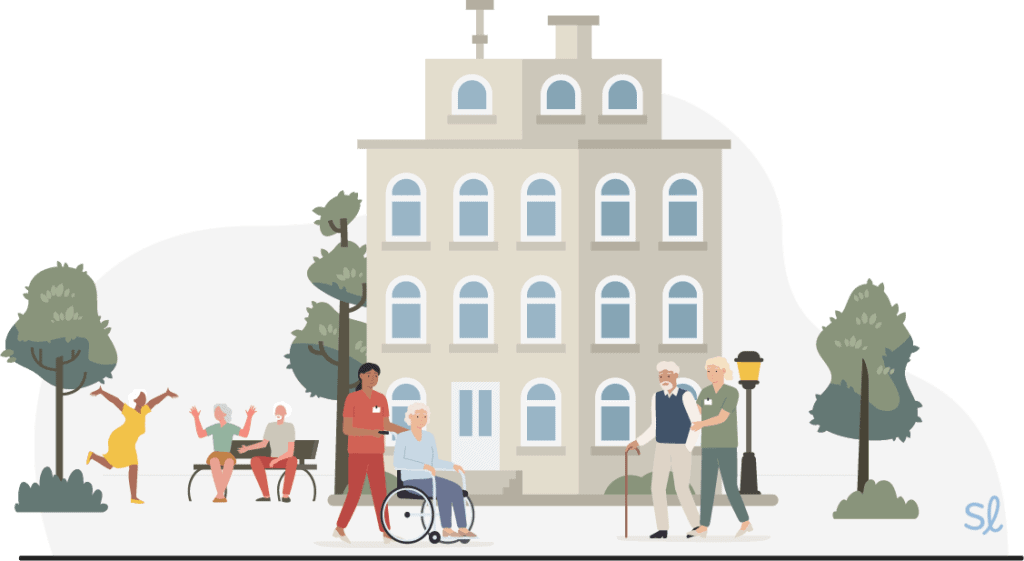A Guide to Long-Term Care for Seniors
There are many long-term care options in 2025 ranging from assisted and independent living to nursing homes and memory care.
SeniorLiving.org is supported by commissions from providers listed on our site. Read our Editorial Guidelines
Find Long Term Care Near You
Join 1,019,247 Seniors Who've Searched for Housing Communities on SeniorLiving.org.
Or Call: (855) 241-1699Find Long Term Care Near You
While aging is a normal part of life, living independently can become more difficult. At a certain point, you or a loved one may need help with daily tasks, managing a health condition such as Huntington’s or Alzheimer's, or recovering after surgery. This is where long-term care services come in.
An individual turning 65 in the United States has a 70 percent chance of needing some sort of long-term care services during the remaining years of their life.1 Long-term care helps older adults age safely, whether they remain at home or move into a residential facility. Since everyone’s needs, budgets, and lifestyles vary, there are a lot of long-term care services to choose from.
While long-term care planning can seem daunting, you can find the best option for you or your loved one with some research. Our guide below covers the different types of care, pricing, factors to consider, payment options, and more.
Table of Contents
- What is Long-Term Care?
- Long-Term Care at Home
- Community-Based Care for Seniors
- Long-Term Care in a Facility or Residential Community
- How to Decide if It’s Time for Long-Term Care
- How Much Do Long-Term Care Services Cost?
- Paying for Long-Term Care
- Long-Term Care Insurance
- Other Long-Term Care-Related Resources
What Is Long-Term Care?
Long-term care is the umbrella term describing care or assistance you need if you can no longer perform activities of daily living (ADLs) on your own. ADLs include bathing, dressing, eating, and using the bathroom.
Sometimes long-term care just means that someone helps you get ready in the morning and at night. In other cases, it means moving into a nursing home while you recover from a fall or surgery or managing a chronic illness. On average, those aged 65 and older who utilize long-term care services require care for up to four years. Only 20 percent of seniors will need it for more than five years.
Types of Long-Term Care
All of your long-term care options fall into one of the following categories: personal care and skilled care.
Personal care, also called custodial care, is for older adults who need help with non-medical tasks, such as:
- ADLs like dressing, bathing, personal hygiene, and transfers
- Instrumental activities of daily living (IADLS) such as grocery shopping, laundry, meal prep, and light cleaning
- Non-medical care
- Companionship
- Housekeeping
- Supervision
- Transportation
Skilled care, or skilled nursing care, is for seniors who need skilled medical care or rehabilitation services such as:
- Vital sign monitoring
- IV treatments/feedings
- Medication management
- Wound care
- Mobility assistance
- Occupation, physical, and speech therapy
Our free housing and care finder uses your unique needs to curate a list of the best options in your area.
Long-Term Care at Home
Many seniors want to age in place, which is why home care is a popular type of long-term care, as it makes this possible. It’s exactly what it sounds like; care is provided right in your home. However, the type of care and how often you or a loved one receive assistance entirely depends on your needs and financial resources.
Home care offers many benefits:
- Lets you age in place and stay in your community
- Keeps spouses who require different levels of care together
- Often more affordable than other long-term care options
- Provides companionship to ward off feelings of isolation and depression
- Reduces stress for seniors
- Supplements the care a friend or family caregiver provides
- Family and friends can visit whenever they want (no strict visitation hours)
Personal Care
With personal care, a non-medical paraprofessional, often referred to as a personal care attendant, helps you with ADLs. Other names include home care companion, companion, caregiver, and personal care aide. This type of home care is helpful for older adults who need extra help to live safely at home but do not require additional medical services. The terms “homemaker services” and “personal care attendants” are sometimes used interchangeably by home care agencies to describe home care paraprofessionals who only offer non-medical care.
Types of care and assistance provided
- Dressing
- Bathing
- Personal hygiene
- Toileting and toilet hygiene
- Feeding
- Mobility assistance
- Transportation
Homemaker Services
A homemaker is a non-medical paraprofessional who assists with home management and instrumental activities of daily living (IADLs). While IADLs are not necessary for functional living, the ability to perform IADL tasks significantly improves the quality of life for older folks.2 The major facets of IADLs include cooking, cleaning, transportation, laundry, and managing finances. Homemaker services are a good option for seniors who need extra help managing their home but do not need additional medical services.
Types of care and assistance provided
- Caring for your pet
- Housekeeping
- Meal preparation and clean up
- Laundry
- Shopping
- Transportation
- Companionship
- Home and finance management
Home Health Care
With home health care, a trained home health aide comes into your home to assist with basic medical care and monitoring. It’s best for seniors who need help with ADLs and/or medical monitoring and basic medical care. Home health aides must meet state-set training requirements, which involves at least 75 hours of training with at least 16 hours being hands-on training.3
Types of care and assistance provided
- Assistance with ADLs
- Vital sign monitoring
- Medication assistance
- IV treatments/feedings
- Mobility assistance
- Wound care
- Monitor your physical and mental condition
Nurse Care
The next level up from home health care is nurse care. With nurse care, a licensed medical professional (registered nurse, physical therapist, occupational therapist, speech therapist) comes into your home to provide more comprehensive medical care for ill or injured seniors.
Quick Tip: If you speak a primary language other than English, visit our guide to finding language-specific senior care.
Seniors who are managing a chronic condition might need ongoing nurse care, whereas a senior’s recovering from surgery may just need in-home therapy services for a few weeks. Nurse care is best for older adults who need more advanced or specialized medical care, medical monitoring, or rehabilitation services.
Types of care and assistance provided
- Skilled nursing care
- Intravenous treatments
- Medical monitoring
- Wound care
- Diabetes care
- Stroke management care
- Physical therapy
- Speech therapy
- Occupational therapy
Hospice Care
Hospice is end-of-life care designed to make your loved one’s remaining time with you as comfortable as possible. It prioritizes their quality of life and pain management over curing an illness. Hospice care is typically for seniors who received a fatal diagnosis, such as a prognosis of six months or less to live.
While anyone can use hospice care, seniors account for 94 percent of the 1.6 million recipients nationwide.4 We put it under home care because hospice care is most often provided in the home. However, you can turn to a nursing home for hospice care as well.
Types of care and assistance provided
- Doctor services and nursing care
- Medical equipment and supplies like wheelchairs and catheters
- Prescription drugs for symptom and pain management
- Physical therapy, occupational therapy, and speech therapy services
- Bereavement counseling
- Dietary counseling
- Social work services
Tool Tip: If you or a loved one are considering in-home care but aren’t sure about financial coverage, check out our guide to in-home care costs.
Community-Based Care for Seniors
You don’t need to let someone in your home or move into a facility to take advantage of long-term care services. Community-based care and services provide seniors and their caregivers with regular or as-needed support outside the home. Some examples include adult day care centers, transportation services, and respite care.
Community-based care offers many benefits:
- Helps seniors feel connected
- Gives family caregivers time off
- Enables seniors to run errands independently
- Keeps you connected with your community
- More affordable than other long-term care options
Community-based care is ideal for seniors who want to get out of the house and for caregivers who need a break. It’s also a great option for seniors with a limited budget.
Adult Day Care
Some families decide to enroll their loved ones in an adult daycare program. This type of care is typically offered Monday through Friday from the morning until early evening, and it gives family caregivers a break, especially if they work during the day or are experiencing caregiver burnout. It’s also great for older adults who want to get out of the house, seniors with Alzheimer’s or dementia who need supervision, and those on a limited budget.
At adult day care, seniors receive supervision and needed health services while also enjoying planned group activities. The level of care between facilities varies. Some specialize in memory care, where extra care is taken to monitor wandering-prone seniors and offer brain activities. Keep in mind that some adult day care providers may offer extended hours or weekend hours. That’s great news for caregivers who don’t work a 9-to-5, Monday-Friday work shift.
Types of care and assistance provided
- Planned social, educational, and wellness activities
- Nutritious meals
- Supervision
- Transportation
- Counseling
- Medical services: medication dispensing, hearing checks, symptom management
- Rehab services: occupational therapy, speech therapy, physical therapy
- Support services for caregivers: counseling, support groups, education
Respite Care
Respite care gives primary caregivers a short break for a day, a few days, or even weeks. Maybe you need to go on a work trip, take a vacation, or have time to yourself each week to attend appointments and see your kids. Whatever the reason, respite care can help.
Respite care is offered by several different types of senior living services. You can arrange respite care through:
- Adult day care
- Nursing homes
- Personal care agencies
- Home health care agencies
Transportation Services
Does your loved one need help getting to appointments or the store? Many communities offer transportation services for seniors at no or low cost. A bus or van picks your loved one up at their home, drops them off where they need to go, and picks them up afterward. This is a great option for seniors who can independently shop and attend appointments but who cannot or choose not to drive. If you’re looking for ways to get around town, check out our guide on transportation for seniors!

SeniorLiving.org is supported by commissions from providers listed on our site. Read our Editorial Guidelines
Long-Term Care in a Facility or Residential Community
Seniors who want to or need to move out of their homes for care can move into a residential community or care facility. Here, you have access to staff 24/7, live amongst your peers, and enjoy scheduled activities.
Residential senior community benefits include:
- 24/7 medical and personal care
- Meets all of a senior’s needs
- Married seniors can often stay together
- Opportunity to participate in social activities and outings
- Provides safety and security
- No more yard work, housework, or meal prep
Moving into a care facility is best for those who can no longer live alone, feel lonely, desire to live around their peers, or need care that cannot be provided in their current home.
Assisted Living Communities
An assisted living community is a senior residential community with staff members who can assist you with ADLs. You live in your own room, apartment, cottage, or small home, but you have access to 24/7 supervision and assistance. It’s best for seniors who want to remain as independent as possible yet still need help with some or many ADLs.
Types of care and services provided5
- Supervision and assistance with personal care tasks and ADLs
- Scheduled recreational, wellness, educational, and social activities
- On-campus amenities like a gym, library, movie room, game room
- Access to three meals a day
- Laundry, housekeeping, linen, and maintenance services
- Medication management
- Transportation
Continuing Care Retirement Communities
Also called a life plan community, a continuing care retirement community (CCRC) provides seniors with continuous care as they age. You enjoy independent living with plenty of amenities and activities, but you also have on-site access to higher-level personal and medical care should you need it. CCRCs are excellent for older adults who want to spend their retirement years in a community that will meet their changing needs as they age, and couples who need different levels of care but want to live together.
Types of care and services provided
- Various residential options: condos, cottages, apartments, duplexes
- On-site medical care available, including assisted living, memory care, and skilled nursing care
- Physical therapy, occupational therapy, speech therapy
- Indoor and outdoor recreational activities and facilities
- Scheduled social, wellness, and educational opportunities
- Community book clubs or crafting clubs
- Transportation
- Housekeeping, linen service, laundry
- Home repairs and maintenance
- CCRCs tend to have lots of amenities too. These could include a beauty salon or barber, a coffee shop, retail and food shops, an art and music studio, and a golf course.
Nursing Homes
Does your loved one need more care than you’re able to provide at home? If so, a nursing home might be their best option. Nursing homes are residential facilities for seniors and those with disabilities that provide medical care, help with ADLs, meals, and laundry. They’re best for older adults who need 24/7 medical monitoring, those who are recovering from a hospital stay, injury, or illness, or seniors with Alzheimer’s or another type of dementia. Think of a nursing home as a step above assisted living. If you or a loved one is considering moving into a nursing home, make sure you have a checklist of features and amenities you want.
Types of care and services provided
- 24/7 supervision and on-site assistance
- On-site medical services (vary depending on the facility)
- Rehabilitation services: occupational therapy, physical therapy, speech therapy
- Help with ADLs
- Shared or private rooms
- Meal service, housekeeping, linen service, laundry
- Social activities like game nights or book clubs
- On-site religious services
- Senior-friendly exercise facilities and opportunities
How to Decide if It’s Time for Long-Term Care
Seven out of 10 people will require long-term care at some point in their lifetime.6 So, even though you may think you don’t need long-term care now, there could very well come a time when you do.
It’s important to understand some signs that can help you know when that time’s coming (or if it’s already here) for you or the senior you care for.
- Physical signs: Experiencing weight loss, worsened balance, decreased energy, or mobility difficulties.
- Mental signs: Memory loss or confusion, feelings of isolation or depression, or forgetting to take medications.
- Other medical signs: New or worsened health conditions, unexplained bruising, or frequent falling or almost falling.
- Visible signs: The house is always messy and cluttered, burn marks in the kitchen from leaving the stove or oven on, or damage to a house’s exterior from a car hitting the home, garage, or fence.
- Hygiene: Unable to safely use the shower, forgetting to brush teeth and wash hands, looking disheveled, or wearing the same clothes day after day.
As you’ve learned so far, you have many long-term care options available. So, don’t stress if you notice that independent living isn’t as easy as it used to be. Just because you’re struggling to get ready in the morning doesn’t mean you need to move out of your home.
Talking with your spouse, loved ones, and medical team is an important part of this decision process too. They may notice changes in you that you don’t see or have recommendations based on your health or financial situation.
Whether your long-term care plan involves an adult child stepping in as your primary caregiver or registering for an adult day care facility specializing in memory care, you won’t know unless you ask. Making the decision to pursue long-term care can be scary, but you are not alone, and there are plenty of resources to help you navigate the next steps.
How Much Do Long-Term Care Services Cost?
Long-term care services can be expensive. Of course, the exact cost varies since you have several different options and may or may not need full-time care. To help give you an idea, we've created this chart showcasing the median national cost by service type.
Estimated Median Cost of Long-Term Care Services in the U.S. by Type (2025)*
| Type of care | Daily median cost | Monthly median cost | Yearly median cost |
|---|---|---|---|
| Homemaker services costs | $201 | $6,068 | $72,820 |
| Home health aide costs | $220 | $6,675 | $80,102 |
| Adult day care costs | $101 | $2,183 | $26,204 |
| Assisted living facility costs | $187 | $5,676 | $68,110 |
| Nursing home: semiprivate room | $302 | $9,197 | $110,360 |
| Nursing home: private room | $339 | $10,326 | $123,913 |
*All data for this chart comes from Genworth’s Cost of Care Survey
Along with the type of care, several other factors influence the cost of long-term care services:
- Number of hours of care required each week
- Time of day that you need care
- Geographic location
- Your chosen service provider or facility
- Whether you need extra services not included in the base price
FYI: Long-term care costs vary from state to state. Our guide to individual state economies may help you get a better idea of costs in your state and how they compare to other areas.
>>Learn More: Long Term Care Calculator
Paying for Long-Term Care
Now that you’ve seen how much long-term care costs, you’re probably wondering, “How do I pay for it?”
Looking at the numbers, affording long-term care might feel impossible, but seniors and their families do it daily. The most commonly used payment methods are:
- Medicare
- Medigap (Medicare Supplemental Insurance)
- Medicaid
- Veteran’s benefits
- Private health insurance
- Long-term care insurance
- Personal savings
- Home care loans
- Reverse mortgages & HELOCs
- Life insurance policy conversion
- Annuities
- Trusts
- Social Security income
Just make note that not every payment option we listed above works for every type of long-term care service. For example, Medicare will only cover in-home skilled nursing care if you’re under the care of a doctor and a doctor certifies that you’re homebound.7
Long-Term Care Insurance
One way to help minimize your long-term care costs is to plan ahead and purchase a long-term care insurance policy. Just as health insurance helps you pay your medical bills, long-term care insurance helps to cover in-home or out-of-home care you may need as you age. Coverage varies depending on the policy.
Common covered expenses include:
- Nursing home facilities
- Memory care facilities
- Assisted living facilities
- In-home care, like skilled nursing care, therapy, and personal care
- Hospice and respite care
- Adult day care centers
Some policies even cover home modifications that make your home more accessible. Think wheelchair ramps or grab bars in your bathroom.
When to Take Out a Long-Term Care Insurance Policy
There isn’t a magic age that indicates the perfect time to take out a long-term care insurance policy; it’s a personal decision that depends on several different factors, including your health and financial stability.
In general, the younger you are and the better your health, the more affordable your premiums will be. Why? Because The cost of long-term care insurance is partially determined by your age and your health. That’s why AARP suggests seeking long-term care insurance between the ages of 60 and 65, or over 55 for couples.8 After that point, your health won’t get any better, so you’ll owe more in premiums.
That’s why AARP suggests seeking long-term care insurance between the ages of 60 and 65, or over 55 for couples.8 After that point, your health won’t get any better, so you’ll owe more in premiums.
If you’re still working, you should check with your employer to see if they offer an employer-sponsored long-term care insurance plan. These plans can save you a lot of money since they’re offered at discounted group rates. Of course, you’ll want to find out if you can keep the plan after you retire or leave. If so, it might be worth taking out a policy while you’re still employed.
Want to learn more about long-term care insurance? In the video below, our editor-in-chief, Jeff Hoyt, will fill you in on everything you need to know.

LongTermCare.gov. (2021). How Much Care Will You Need?
National Library of Medicine. (2021). Instrumental Activity of Daily Living.
AARP. (2019). Home Health Aides: When Your Loved One Needs Help With Personal Care.
Centers for Disease Control and Prevention. (2019). Vital and Health Statistics.
National Institute on Aging. (2021). Residential Facilities, Assisted Living, and Nursing Homes.
Genworth. (2025). Cost of Care Survey.
Medicare.gov. (2021). Home health services.
AARP. (2019). Buy Long-Term Care Insurance at the Right Age to Get the Best Value.





